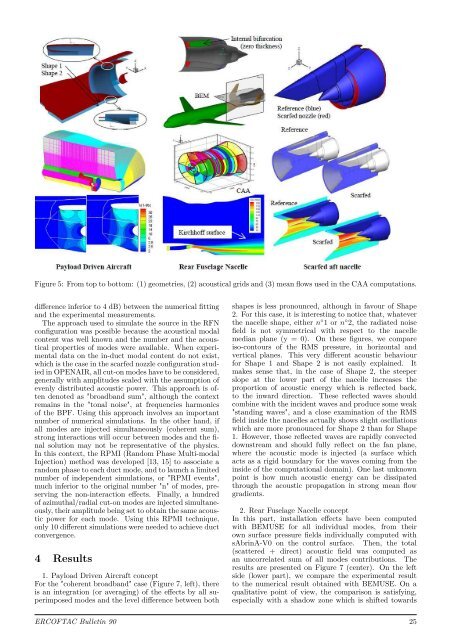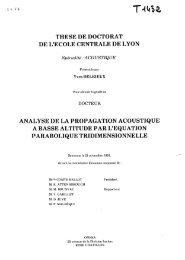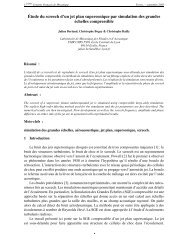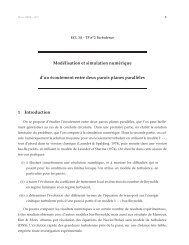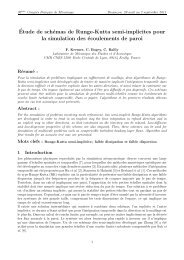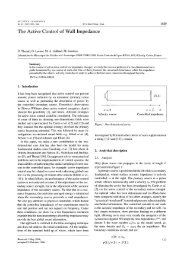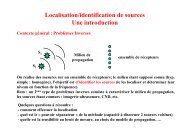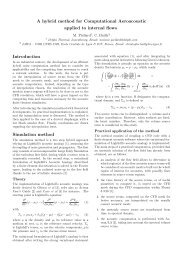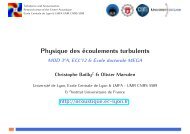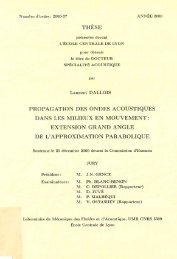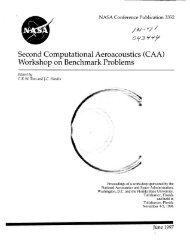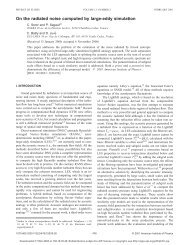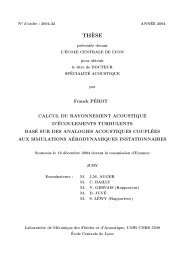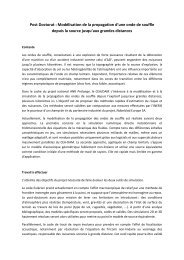ERCOFTAC Bulletin - Centre Acoustique
ERCOFTAC Bulletin - Centre Acoustique
ERCOFTAC Bulletin - Centre Acoustique
Create successful ePaper yourself
Turn your PDF publications into a flip-book with our unique Google optimized e-Paper software.
Figure 5: From top to bottom: (1) geometries, (2) acoustical grids and (3) mean flows used in the CAA computations.<br />
difference inferior to 4 dB) between the numerical fitting<br />
and the experimental measurements.<br />
The approach used to simulate the source in the RFN<br />
configuration was possible because the acoustical modal<br />
content was well known and the number and the acoustical<br />
properties of modes were available. When experimental<br />
data on the in-duct modal content do not exist,<br />
which is the case in the scarfed nozzle configuration studied<br />
in OPENAIR, all cut-on modes have to be considered,<br />
generally with amplitudes scaled with the assumption of<br />
evenly distributed acoustic power. This approach is often<br />
denoted as "broadband sum", although the context<br />
remains in the "tonal noise", at frequencies harmonics<br />
of the BPF. Using this approach involves an important<br />
number of numerical simulations. In the other hand, if<br />
all modes are injected simultaneously (coherent sum),<br />
strong interactions will occur between modes and the final<br />
solution may not be representative of the physics.<br />
In this context, the RPMI (Random Phase Multi-modal<br />
Injection) method was developed [13, 15] to associate a<br />
random phase to each duct mode, and to launch a limited<br />
number of independent simulations, or "RPMI events",<br />
much inferior to the original number "n" of modes, preserving<br />
the non-interaction effects. Finally, a hundred<br />
of azimuthal/radial cut-on modes are injected simultaneously,<br />
their amplitude being set to obtain the same acoustic<br />
power for each mode. Using this RPMI technique,<br />
only 10 different simulations were needed to achieve duct<br />
convergence.<br />
4 Results<br />
1. Payload Driven Aircraft concept<br />
For the "coherent broadband" case (Figure 7, left), there<br />
is an integration (or averaging) of the effects by all superimposed<br />
modes and the level difference between both<br />
shapes is less pronounced, although in favour of Shape<br />
2. For this case, it is interesting to notice that, whatever<br />
the nacelle shape, either n ◦ 1 or n ◦ 2, the radiated noise<br />
field is not symmetrical with respect to the nacelle<br />
median plane (y = 0). On these figures, we compare<br />
iso-contours of the RMS pressure, in horizontal and<br />
vertical planes. This very different acoustic behaviour<br />
for Shape 1 and Shape 2 is not easily explained. It<br />
makes sense that, in the case of Shape 2, the steeper<br />
slope at the lower part of the nacelle increases the<br />
proportion of acoustic energy which is reflected back,<br />
to the inward direction. These reflected waves should<br />
combine with the incident waves and produce some weak<br />
"standing waves", and a close examination of the RMS<br />
field inside the nacelles actually shows slight oscillations<br />
which are more pronounced for Shape 2 than for Shape<br />
1. However, those reflected waves are rapidly convected<br />
downstream and should fully reflect on the fan plane,<br />
where the acoustic mode is injected (a surface which<br />
acts as a rigid boundary for the waves coming from the<br />
inside of the computational domain). One last unknown<br />
point is how much acoustic energy can be dissipated<br />
through the acoustic propagation in strong mean flow<br />
gradients.<br />
2. Rear Fuselage Nacelle concept<br />
In this part, installation effects have been computed<br />
with BEMUSE for all individual modes, from their<br />
own surface pressure fields individually computed with<br />
sAbrinA-V0 on the control surface. Then, the total<br />
(scattered + direct) acoustic field was computed as<br />
an uncorrelated sum of all modes contributions. The<br />
results are presented on Figure 7 (center). On the left<br />
side (lower part), we compare the experimental result<br />
to the numerical result obtained with BEMUSE. On a<br />
qualitative point of view, the comparison is satisfying,<br />
especially with a shadow zone which is shifted towards<br />
<strong>ERCOFTAC</strong> <strong>Bulletin</strong> 90 25


